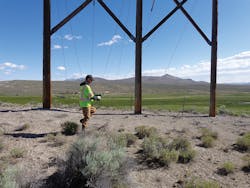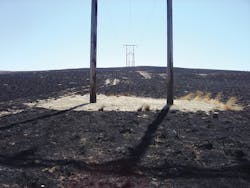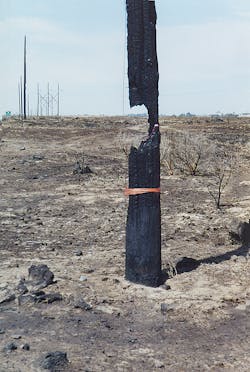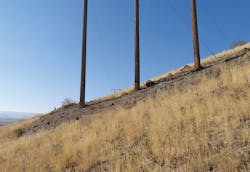Utilities across the western United States face many unique challenges in providing and maintaining reliable power to their customers. A prime example is the frequency of fires and number of wildland acres burned in each incident, both on alarming upward trends. Natural fires, such as those caused by dry lightning strikes, and fires caused by humans, such as from vehicles and campfires, occur every year during the hot summer months. These fires travel for miles and often find their way to utility lines.
Many wood poles located in high-fuel areas, such as dry grass, brush and forested landscapes, have been in place for decades, have become weathered and are vulnerable to fire. Older poles typically contain large cracks, or checks, that often catch flying embers, depending on factors such as wind speed and direction. Newer poles also are vulnerable to fire. Fortunately, a proven approach to vegetation control can be used successfully as a means for fire mitigation.
Because of fire-related damage and losses to utility structures, in the last several years, more utilities have begun applying granular herbicides around the base of wood poles to create a vegetation-free zone or near-vegetation-free zone, which provides a firebreak when a wildfire passes through the line. This creation of defensible space reduces the heat and flame exposure of a pole.
A Safe, Easy Response
Applications of granular herbicides can be made safely and easily with a handheld granular spreader. The granular formulation has many benefits, versus a typical liquid formulation. These products are ready to use out of the container; there is no mixing of concentrated materials and water is not needed. This is a helpful feature as water is sometimes difficult to obtain and haul in mountainous and remote areas that may cover hundreds of rural miles.
These types of herbicides are similar in size, shape and appearance to a typical turf fertilizer. They are formulated on a heavy, coated limestone and are not prone to drift, as opposed to a liquid application. The granule formulation enables the product to penetrate and not get tied up on the dense, almost impenetrable duff layer, which results in carpet-like stands from flammable annual grasses such as cheatgrass and medusahead.
The granule formulation also has proven to be sun tolerant and excels in hot, dry conditions where there is little to no measurable rainfall for several weeks. The granules are somewhat shaded and more protected from herbicide degrading sunlight than a thin layer of spray applied over the weed and soil surface.
The residual, or the duration of activity, of herbicides does vary considerably. However, the products discussed here are found in the extended residual category, which means — in dry fire-prone areas that do not experience much rainfall — an application is not needed on an annual basis and one treatment may benefit utilities for multiple years. The length of activity is dependent on variables such as annual precipitation, soil type and other factors. The extended residual feature of these products is crucial because many rural utility lines are difficult and costly to visit on an annual basis. Further, fewer trips through a line route mean less chemical used and fewer disturbances to the area involved.
Application Tips and Cost
Granular herbicides may be applied at any time of the year with excellent results, even after several weeks of hot, dry weather with no rainfall events. However, ideally, the product should be applied just prior to the rainy season and not when the ground is frozen. In mountainous areas, the only time available to treat the area is during the dry, snow-free summer months.
"Since we began using granular herbicides for vegetation management around our transmission wood pole structures, we’ve experienced less damage to our infrastructure, even when faced with large fires burning through our ROW," says Greg Wilfong, line foreman III with the Bonneville Power Administration.
Wilfong’s district applies the herbicide during the winter and early spring using hand spreaders. He has found reduced applications are appropriate in some areas with fragile soil to leave enough vegetation to minimize erosion.
When and where total control is not desired, low rates of granular product application have been shown to thin vegetation effectively without complete elimination. Very low rates of granular products will leave enough untreated space between each granule and allow some vegetation to grow through.
The desired vegetation-free radius around a pole is best determined by the type of vegetation present. It is known brush fires may burn hotter and produce more heat and embers than the flammable annual grasses do; therefore, they should be given a few more feet of defensible space. It also has been observed poles in areas of untreated stands of annual grasses have been lost because of fire.
Of course, every fire is different based on many factors, such as ambient temperature, humidity, time of day, wind direction and wind speed. Pole losses from wildfire events are highest in dense, tall brush and when the wind and fire direction are both parallel to the power line.
The cost of a granular fertilizer application depends on variables such as the type of existing vegetation present, soil area to be treated, specific herbicide used and rate of application. Utilities typically have chosen to treat anywhere from a 4-ft to a 15-ft radius around poles. The cost for the herbicide ranges from about $3 per pole to $12 per pole. This cost is greatly outweighed by the cost to replace a damaged pole, which easily can top $5,000 or much more.
Other costs also may be relevant such as lost revenue from customers, the cost of replacement hardware and the labor cost involved with restringing a line. Utilities that have performed this type of basic cost-benefit analysis have learned advanced treatment is clearly in their favor should a wildfire strike. A few quick calculations will overwhelmingly demonstrate it only takes a loss of a few poles to make up the cost of a comprehensive herbicide application.
Harney Electric Cooperative Inc. has a 20,000-sq-mile service territory with lines constructed over many miles of desert land that is predominately covered with brush and annual grasses. "We have found that, to minimize the risk of fire starts and to minimize the cost of clearing structures on the ROW, herbicides can be put around poles in fire hazard areas during the early spring and late fall months," says Jason Hill, Harney Electric Cooperative line superintendent. "Based on research and considerable experience, Harney Electric Cooperative also has found that herbicides are essential to our maintenance program for vegetation management while keeping costs down."
Additional Uses and Considerations
While fires often advance toward power lines, there have been many instances of fires originating at a distribution pole and spreading away from the pole, leading to a wildfire. Many distribution poles carry hardware that can spark or ignite dry grass or brush below. A fuel-free zone created through herbicide use around the ground penetration area of a pole can prevent the spark or fire from igniting and spreading.
Idaho Power Co., which provides electricity for more than 540,000 customers, started an herbicide application program around wood transmission poles in 2006. From 2012 to 2017, they documented losses of treated and non-treated poles. Figures revealed poles were lost at a 7% rate from wildfires in treated areas. In untreated areas, poles were lost at a rate of 40%. Wayne Olson, a utility arborist for Idaho Power, says, "Where we can, we mechanically clear a 20-ft radius around wood poles and chemically treat a 15-ft radius."
In addition to substantially reducing loss from fire damage, there are many other benefits to removing vegetation around poles and towers in essentially all areas of the country. Creating and maintaining a clean area makes accessibility much easier and is appreciated by maintenance and inspection personnel. Inspections are faster and safer to perform with the increased visibility resulting from vegetation removal. Finally, areas free of vegetation are not subject to animal damage because chewing rodents, stinging insects and biting snakes normally prefer weed- and brush-covered environments.
In addition to reducing habitat for unwanted critters, there is another good reason to keep vegetation away from poles and tower legs, particularly in wetter climates. There is less moisture present at the base of wood poles when surrounded by a vegetation-free zone. Plants trap moisture and contain acids that contribute to the breakdown of wood fiber in poles. Pole failure from rot and insects often occurs at the soil-air interface at the ground line. Also, corrosion of metal tower bases and guy wire anchors is less prevalent when the ground surface surrounding them can dry out between precipitation events.
In the eastern states, granular herbicides are used widely and effectively in areas where weeds, brush and vine species are present. Vines have a way of being attracted to steel towers and can climb easily up tower legs. The convenient granule form of herbicides can penetrate the thick mass of the foliage and reach the soil zone where it does its work.
Electric utilities have many other areas on their systems beside pole lines where a herbicide application may be beneficial. For instance, transformer-mounted banks, which contain a lot of hardware, are costly and may be difficult to replace. A lot of expense can be saved if a fire is kept away from the support poles. Also, there is a safety concern when vegetation can grow around and through switch grates. In addition, poles referred to as deadends can be a source of sparks and fire. These are just a few of the many examples where granular herbicide applications could be an ideal means of preventing future problems.
System Vulnerability
Utilities have found new ways granular herbicides can be used to mitigate the risk of fires and provide other benefits to personnel located in all parts of the U.S. All utilities face challenges unique to their geography and climate, and utility personnel must decide how to implement the best management practices, which will produce and transfer reliable and affordable electricity to customers. While utilities have learned it is nearly impossible to eliminate entirely the risk of damage and loss of poles from wildfire events, ongoing experience has demonstrated damage is reduced with vegetation-free zones and this may be a best management practice for the future. ♦
Paul Escobar handles sales responsibilities for the western United States for the SSI Maxim Co. Inc. He has more than 20 years of experience helping electric utilities deal with problem vegetation. He holds a bachelor’s degree from California Polytechnic State University, San Luis Obispo, and is a member of the Utility Arborist Association.
About the Author
Paul Escobar
Paul Escobar handles sales responsibilities for the western United States for the SSI Maxim Co. Inc. He has more than 20 years of experience in helping electric utilities to deal with problem vegetation. He holds a bachelor’s degree from California Polytechnic State University, San Luis Obispo, and is a member of the Utility Arborist Association.






